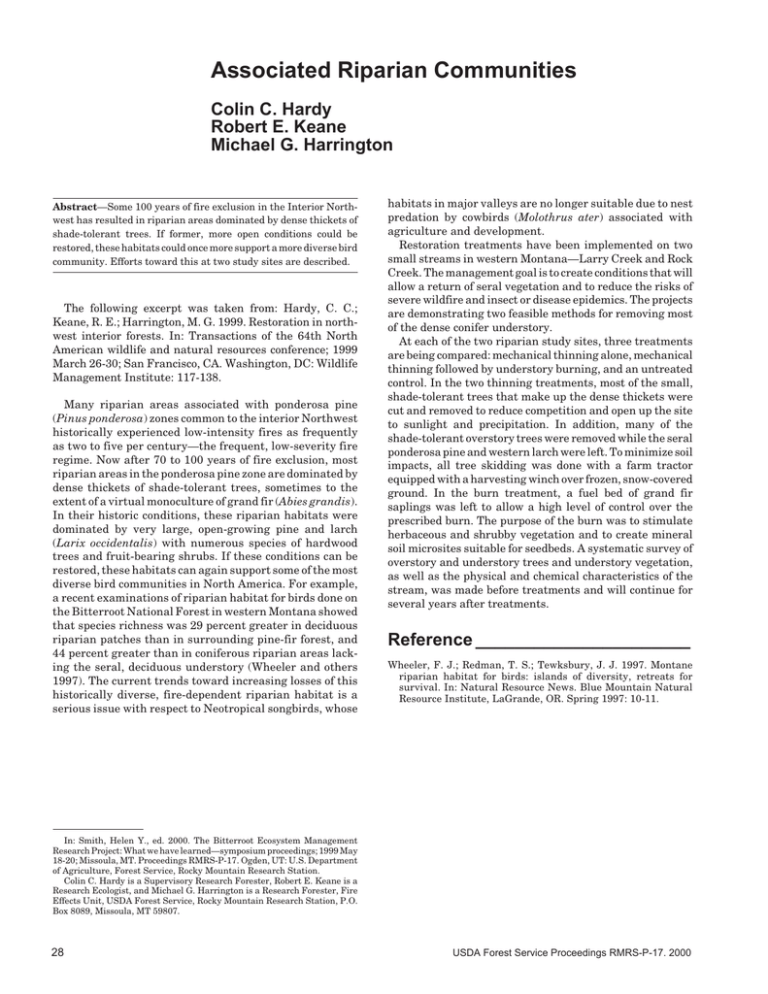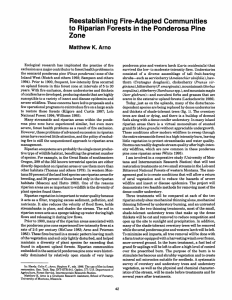Associated Riparian Communities Colin C. Hardy Robert E. Keane Michael G. Harrington
advertisement

Associated Riparian Communities Colin C. Hardy Robert E. Keane Michael G. Harrington Abstract—Some 100 years of fire exclusion in the Interior Northwest has resulted in riparian areas dominated by dense thickets of shade-tolerant trees. If former, more open conditions could be restored, these habitats could once more support a more diverse bird community. Efforts toward this at two study sites are described. The following excerpt was taken from: Hardy, C. C.; Keane, R. E.; Harrington, M. G. 1999. Restoration in northwest interior forests. In: Transactions of the 64th North American wildlife and natural resources conference; 1999 March 26-30; San Francisco, CA. Washington, DC: Wildlife Management Institute: 117-138. Many riparian areas associated with ponderosa pine (Pinus ponderosa) zones common to the interior Northwest historically experienced low-intensity fires as frequently as two to five per century—the frequent, low-severity fire regime. Now after 70 to 100 years of fire exclusion, most riparian areas in the ponderosa pine zone are dominated by dense thickets of shade-tolerant trees, sometimes to the extent of a virtual monoculture of grand fir (Abies grandis). In their historic conditions, these riparian habitats were dominated by very large, open-growing pine and larch (Larix occidentalis) with numerous species of hardwood trees and fruit-bearing shrubs. If these conditions can be restored, these habitats can again support some of the most diverse bird communities in North America. For example, a recent examinations of riparian habitat for birds done on the Bitterroot National Forest in western Montana showed that species richness was 29 percent greater in deciduous riparian patches than in surrounding pine-fir forest, and 44 percent greater than in coniferous riparian areas lacking the seral, deciduous understory (Wheeler and others 1997). The current trends toward increasing losses of this historically diverse, fire-dependent riparian habitat is a serious issue with respect to Neotropical songbirds, whose habitats in major valleys are no longer suitable due to nest predation by cowbirds (Molothrus ater) associated with agriculture and development. Restoration treatments have been implemented on two small streams in western Montana—Larry Creek and Rock Creek. The management goal is to create conditions that will allow a return of seral vegetation and to reduce the risks of severe wildfire and insect or disease epidemics. The projects are demonstrating two feasible methods for removing most of the dense conifer understory. At each of the two riparian study sites, three treatments are being compared: mechanical thinning alone, mechanical thinning followed by understory burning, and an untreated control. In the two thinning treatments, most of the small, shade-tolerant trees that make up the dense thickets were cut and removed to reduce competition and open up the site to sunlight and precipitation. In addition, many of the shade-tolerant overstory trees were removed while the seral ponderosa pine and western larch were left. To minimize soil impacts, all tree skidding was done with a farm tractor equipped with a harvesting winch over frozen, snow-covered ground. In the burn treatment, a fuel bed of grand fir saplings was left to allow a high level of control over the prescribed burn. The purpose of the burn was to stimulate herbaceous and shrubby vegetation and to create mineral soil microsites suitable for seedbeds. A systematic survey of overstory and understory trees and understory vegetation, as well as the physical and chemical characteristics of the stream, was made before treatments and will continue for several years after treatments. Reference ______________________ Wheeler, F. J.; Redman, T. S.; Tewksbury, J. J. 1997. Montane riparian habitat for birds: islands of diversity, retreats for survival. In: Natural Resource News. Blue Mountain Natural Resource Institute, LaGrande, OR. Spring 1997: 10-11. In: Smith, Helen Y., ed. 2000. The Bitterroot Ecosystem Management Research Project: What we have learned—symposium proceedings; 1999 May 18-20; Missoula, MT. Proceedings RMRS-P-17. Ogden, UT: U.S. Department of Agriculture, Forest Service, Rocky Mountain Research Station. Colin C. Hardy is a Supervisory Research Forester, Robert E. Keane is a Research Ecologist, and Michael G. Harrington is a Research Forester, Fire Effects Unit, USDA Forest Service, Rocky Mountain Research Station, P.O. Box 8089, Missoula, MT 59807. 28 USDA Forest Service Proceedings RMRS-P-17. 2000








